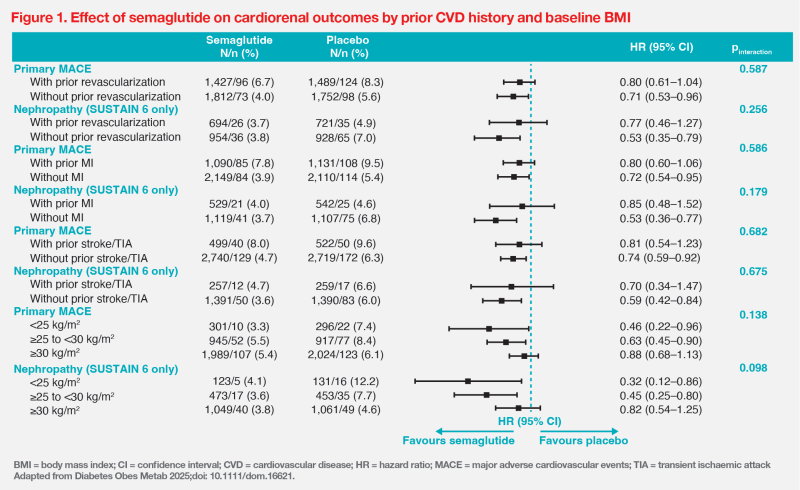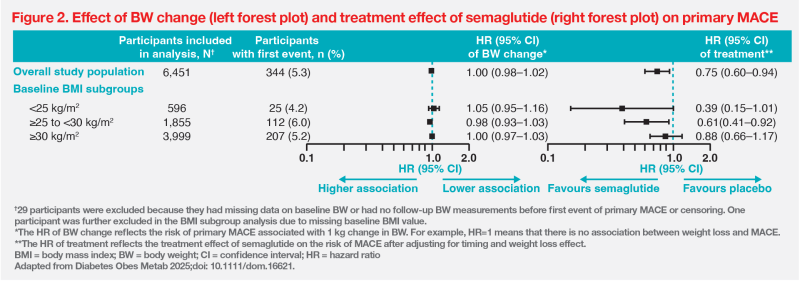
Previous analyses found that body weight reduction does not predict the cardiorenal benefits of glucagon-like peptide-1 receptor agonists (GLP-1 RAs; eg, semaglutide). A pooled post-hoc analysis of the SUSTAIN 6 and PIONEER 6 trials demonstrated that semaglutide improved cardiorenal outcomes in a diverse population of patients with type 2 diabetes (T2D), regardless of prior history of cardiovascular disease (CVD) and baseline body mass index (BMI). The CV benefit remained consistent even when accounting for various degrees of weight loss.
GLP-1 RAs: Weight loss not predictive of cardiorenal benefits
GLP-1 RAs, initially developed for glycaemic and weight control, improve cardiorenal outcomes in patients with T2D and high CV risk. [Cell Rep Med 2025;6:102214]
The exact mechanism driving the cardiorenal effects remains unclear. While weight loss has been suggested as a potential indirect contributor, previous analyses indicated that the degree of weight loss did not predict GLP-1 RAs’ cardiorenal effects. [Diabetes Obes Metab 2025;doi:10.1111/dom.16621; Diabetes Care 2020;43:1546-1552; Cardiovasc Diabetol 2021;20:194; Diabetes Obes Metab 2021;23:2058-2066]
SUSTAIN 6 & PIONEER 6 pooled analysis
To investigate the cardiorenal effects of semaglutide in patients with T2D and high CV risk, researchers conducted a pooled post-hoc analysis of two cardiovascular outcome trials, SUSTAIN 6 (subcutaneous semaglutide 0.5 or 1.0 mg Q1W; n=3,297) and PIONEER 6 (oral semaglutide 14 mg QD; n=3,183), with a minimum of 122 major adverse cardiovascular events (MACE) needed to ascertain statistical power. [Diabetes Obes Metab 2025;doi:10.1111/dom.16621]
In the overall population (n=6,480; mean age, 64.4–65.9 years; male, ≥53 percent; history of ≥1 CVD event at baseline, >80 percent), semaglutide significantly reduced the risks of primary MACE (ie, CV death, nonfatal MI, or nonfatal stroke) by 24 percent (hazard ratio [HR], 0.76; 95 percent confidence interval [CI], 0.62–0.92; p=0.0062) and nonfatal stroke by 35 percent (HR, 0.65; 95 percent CI, 0.43–0.97; p=0.0346) vs placebo.
Semaglutide also reduced the risk of nephropathy by 36 percent (HR, 0.64; 95 percent CI, 0.46–0.88; p=0.0054) vs placebo in the SUSTAIN 6 population. “Time to first new or worsening of nephropathy was evaluated in SUSTAIN 6 only, as kidney-related outcomes were not assessed in PIONEER 6,” noted the researchers.
Cardiorenal protection regardless of CVD history and baseline BMI
The overall pooled population was stratified by CVD history or baseline BMI. [Diabetes Obes Metab 2025;doi:10.1111/ dom.16621]
The risk of primary MACE was consistently lower with semaglutide vs placebo, irrespective of CVD history, such as prior revascularization, MI, and stroke or transient ischaemic attack (TIA) (pinteraction >0.05 for all comparisons). (Figure 1)

“To our knowledge, this is the first analysis that explores the impact of CVD history in further detail,” noted the researchers.
The researchers also investigated semaglutide’s cardiorenal effects across a wide range of baseline BMI to gain further insights into whether the beneficial effects are weight-dependent.
Semaglutide was associated with significantly lower risks of primary MACE and nephropathy, regardless of baseline BMI (pinteraction >0.05 for both). “Differences in baseline BMI, even in those with lean body weight [BMI <25 kg/m2], did not impact semaglutide’s effect on the evaluated CV and kidney-related outcomes,” highlighted the researchers.(Figure 1)
CV benefits consistent when accounting for degree of weight loss
In the left forest plot of Figure 2, the HR for body weight change reflects the risk of primary MACE associated with 1 kg change in body weight. Results showing a 95 percent CI that crosses 1 indicate that there was no significant association between weight loss and risk of primary MACE in both the overall population and across baseline BMI subgroups. [Diabetes Obes Metab 2025;doi:10.1111/ dom.16621]

After adjusting for timing and weight loss effect, the treatment effect of semaglutide in MACE reduction remained generally consistent across baseline BMI subgroups, as shown in the similar HRs in the right forest plot of Figure 2 vs Figure 1. “Semaglutide’s treatment effect on the risk of primary MACE in patients with T2D in different baseline BMI categories remained consistent even when accounting for changes in body weight … indicating that semaglutide may act independently of weight loss,” noted the researchers.
“Semaglutide may have a direct effect on the CV system and kidneys. Cardiorenal benefits of GLP-1 RAs are partly influenced by improved HbA1c, reduced albuminuria, and reduced systolic blood pressure, with no or minimal influence by body weight changes,” explained the researchers.
Conclusion
The pooled post-hoc analysis confirmed that the beneficial cardiorenal effects of semaglutide vs placebo were consistent in patients with T2D and high CV risk, regardless of CVD history and baseline BMI, even after accounting for changes in body weight. [Diabetes Obes Metab 2025;doi:10.1111/dom.16621]
“By simultaneously analyzing several baseline characteristics that contribute to disease heterogeneity and diabetes-associated comorbidities, our analysis supports the use of once-weekly subcutaneous and once-daily oral semaglutide in a diverse T2D population,” stated the researchers.